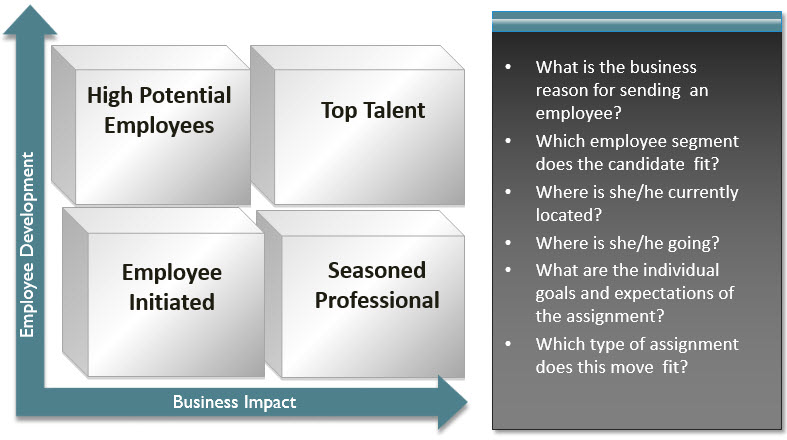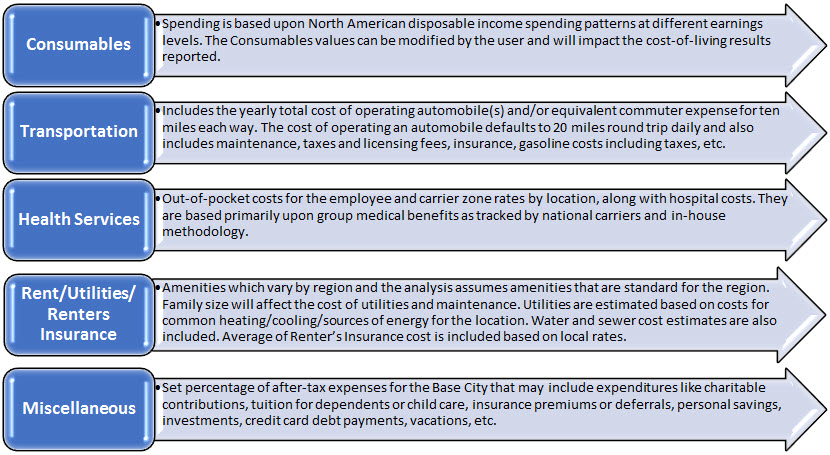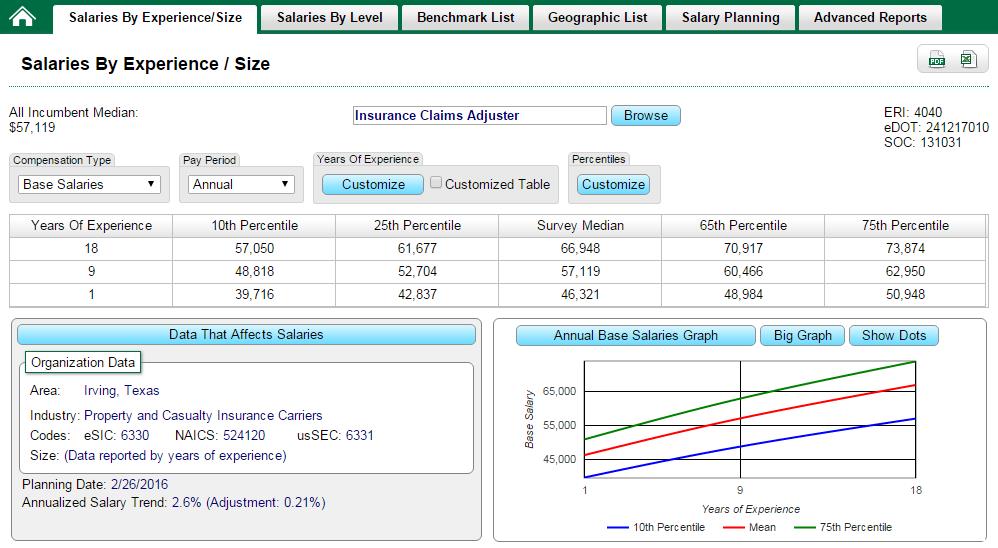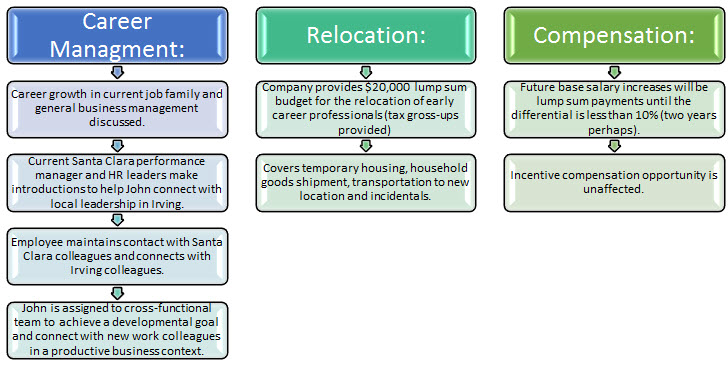Organizations are offering more innovative, flexible relocation programs as a way to align talent management strategies to business operation demands and to better compete in the war for talent. The employee (and family members), performance managers, and human resources are critical stakeholders in the process. Whether the company initiates a relocation for business and professional development purposes or the employee initiates it for personal family or career interests, the stakeholders collaborate to make an informed decision about the move. Cost of living, compensation, and career management are three factors that need to be evaluated to ensure a relocation is successful (see ERI Distance Learning Center course #57, Relocate an Employee Within the United States, for more information on this topic).
Insight from HR leaders might include the following:

Aligning total rewards with talent management programs helps to drive positive business outcomes. The graphics below offer a framework to evaluate relocation programs by the type of talent relative to the business impact and employee development.

Another layer of analysis involves segmenting the employee profiles by their demographics. When employee demographics are combined with the type of talent, you can gain insight to design the most cost-effective relocation programs. The graphic below shows one way to segment employee demographics (although the age categories may not always correspond to the attributes).

For example, best practices organizations are pairing less experienced employees with empty nesters who have depth and breadth of experience than can be shared with or transferred to other staff as part of career development through training, mentorship, or coaching programs. Also, for these empty nesters, relocations to lower cost-of-living operations may support their financial goals.
Relocating an employee requires a significant amount of financial investment and employee commitment to be successful. A move can typically cost anywhere from $25K up to $3M for an executive relocation. Making a well informed decision related to cost-of-living differences and how the household’s standard of living will be affected will contribute to the success of a relocation. Key inputs to understanding cost-of-living differentials include evaluating six categories of expenditures:


ERI’s Relocation Assessor is a trusted source for cost-of-living analytics that help companies support talent management objectives and related relocation processes. The analysis is customized to the employee scenario with several inputs that are user-defined. Let’s take a look at the cost-of-living analytics table of an employee relocation for an early career professional, John Smith, with the following inputs:
- Employee Earnings = $58,000 (e.g., $55,000 base salary plus $3,000 annual incentive)
- Tax Residence = U.S.
- Family Size = 1
- Base City = Santa Clara, CA
- Destination City = Irving , TX
- Housing:
- Square Footage = 700
- Rent or Own? = Rent
- House Payment Assumptions for Homeowners = Not Applicable
- Automobile:
- Number Owned = 1
- Total Value = $10,000
- Mileage = 20,000
Relocation Assessor – Two City Cost Comparison:

Based on John Smith’s scenario, the cost of living in Irving, Texas, is 30.9% lower than in Santa Clara, CA. Housing is the largest expenditure and represents most of the savings in this move ($13,022), then taxes ($2,458), consumables ($1,457), transportation ($861), and health services ($121). There are financial advantages from a cost-of-living perspective.
Next, assess the compensation implications associated with a relocation. The base salary compensation programs for early career professionals are generally based on local labor markets. Further analysis of John Smith’s move to Irving, Texas, will require aligning to geographic salary levels for internal equity, broader engagement, and talent retention objectives. Continuing with this example, we start by comparing the base salary benchmarks for John Smith’s job, Insurance Claims Adjuster, in Santa Clara versus Irving, while also adjusting for the Property and Casualty Insurance Carriers industry differential.
Salary Assessor – Base Salary Benchmark for Santa Clara:


Based on the two Insurance Claims Adjuster salary benchmarks, the Irving labor markets differential is $8,738, which is 15.9% lower than Santa Clara, with the median salaries of $46,321 and $55,059, respectively, for an incumbent with one year of experience. John’s employer has regional geographic structures that assign a work location to a different region when there is at least a 10% differential, which is evaluated on yearly basis. Santa Clara is in a Tier 2 region and Irving is in a Tier 3 region (Tier 1 has NYC, Greenwich, CT, and Palo Alto, CA). See ERI Distance Learning Center course #83, Designing a Branch Office Salary Structure, for more information on geographic structures.
Next, career management is the more complex topic which evaluates employee’s career goals and development plans relative to the relocation and broader organization business objectives. Best practices in career management can include aligning career goals with business objectives, continuous learning culture, business leadership sponsorship, cross-functional support, and employee ownership and self-assessment. The glue in effective best practices includes communication and transparency.
Now the stakeholders have a complete picture of the financial and non-financial implications of John Smith’s relocation to Irving from Santa Clara as follows:

Summary
Competing and winning in the war for talent requires flexible, proactive relocation programs to be responsive to changing business needs from operations and workforce perspectives. High performance organizations support relocation programs with financial and non-financial total rewards policies that are fair, competitive, and foster employee career growth and retention. By doing so, they are expanding their internal labor market capability and their employer brand equity, which are differentiating competitive advantages for the organization. If you have any questions or want to discuss salary and relocation analytics further, call our “best in class” service team at 1-800-627-3697 or visit www.erieri.com.


